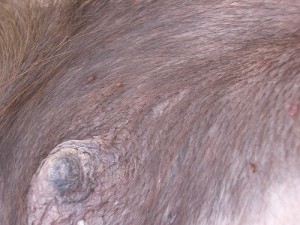Click Here to Buy the Best Treatment to Get Rid of Fleas on Dogs!

I had a hard time recently getting rid of fleas on the dogs in my care. The poor little guys were scratching themselves rotten with the little blighters and I was at my wit’s end. I initially tried to look for a natural dog flea treatment that would avoid the use of any harsh chemicals. But what I soon realised was that firstly, the chemicals used these days are carefully tested to minimise any side effects on your pet and secondly, you can try as hard as you like to get the job done with natural or herbal flea control products, but in my experience nothing is more effective at flea removal from dogs than a proper, full-strength spot on flea treatment.
Something else that I hadn’t realised is that not only do you need a means of ridding yuour pet of the dreaded itchy fiends, but you also need some kind of plan of action for home flea treatment to remove them from your carpets, furniture, your dog’s bedding and so on. This is something that many people miss and then wonder why, just a short time later, Rover has yet another dose of the fleas. The all too common answer is that they’ve just been hiding out in the nooks and crannies of their home waiting for a chance to re-infest the family pet. A home flea control strategy can help to avoid that problem.
One of the best options in my view for flea treatment for home use is a spot on like frontline for dogs (or frontline plus for dogs, which has an extra active ingredient for killing flea eggs and larvae, thereby interruping the life cycle of the flea).I did quite a lot of research into the problem of dogs and fleas at the time of all the itching and scratching. I know a couple of people in the veterinary industry and some of the facts that I discovered are worth sharing with you here.
Before we dive into the nitty gritty, I’d like to share a video with you that illustrates the importance of a good, preventative flea control regimen and what can happen if you allow fleas to go untreated. Please be warned that the video may be upsetting to some of you so if you think you might get too upset, then please don’t watch it. For those of you prepared to watch, you will never forget to give your pet its regular preventative flea treatment again. I for one could not live with myself if I knew I’d allowed any pet of mine to get to such an advanced stage of flea infestation. Here’s the video (you’ve been warned).
If you watched the video in full, those images of the blood being washed out of the dog’s coat and the fleas jumping up onto its head in a vein attempt to escape the flea dip will give you nightmares. The poor little guy was really suffering. Don’t let that happen to your pooch.
Dogs and Fleas
Fleas come under the heading of ectoparasites, which simply means pests that live on the surface of the host. They are the most common dog parasite and range in length from 1mm to 3mm depending on the type. The adult fleas lay hundreds of eggs and these will fall from the animal and remain viable and can go on to develop in carpets and even between gaps in floorboards. In this way, the eggs remain a constant source of reinfection.
There are several different species of flea that primarily stick with the same host. Some fleas specialise in birds, others in cats or humans, but all of them can (unfortunately) affect dogs, which means that poor poochy is at multiple risk from infestation.
Fleas and ticks can cause other problems in your pet, too. These could include flea bite allergies, tapeworm, Lyme’s Disease (which is particularly nasty and often incorrectly diagnosed), and Rocky Mountain spotted fever. With a list of potential complications that long, I’m sure you’ll agree that preventiion is far better than cure.
Given that tapeworms can be carried by fleas, if your dog gets them, in addition to giving your dog flea treatment, make sure that his worming is up to date. Puppies can be wormed as well as treated for fleas from as early as 2 to 4 weeks so there’s no excuse for skiping this treatment even in young dogs.
How to Tell If Your Dog Has Fleas
Dog fleas symptoms are pretty straightforward.They are visible to the naked eye, as you will have seen in the above video.
You can see them crawling and jumping, particularly at bath time when the dog’s hair is wet and they are scrambling to the head to escape drowning.
Fleas are also more obvious on a dog’s belly because the hair is thinner there. You might be able to make out the three fleas lurking in the picture on the left.
Dog Flea Treatment
There are a number of options for dog flea protection and treatment ranging from the mild and herbal to the full-strength scientific, chemical based approach.
A very cheap flea treatment that I’ve seen some people advocate is simply to hold the dog underwater (with its head above the water so it can still breath, obviously) for 15 minutes. I don’t know whether these people have particularly patient and placid dogs but my own dog would get bored of that treatment method after a few short seconds, never mind 15 long minutes.
I’ve also heard people talking about food supplements as treatment options. These could include brewer’s yeast and vitamin B but I remain extremely sceptical about whether they work or not.
In order to completely get rid of fleas, you must pay attention to the three areas that pose the greatest risk of reinfestation. These can be summarised as follows:
- Getting rid of fleas in the house
- Get rid of fleas on dogs
- Outdoor flea control
Lets Take each one in turn.
Getting Rid of Fleas in the House
The key to getting rid of fleas in the house (and ensuring they don’t come back) is regular, consistent treatment.
Initially, to treat the infestation you might want to use a spray or fogger containing a quick kill component that will kill the adult fleas. For best results, this should be combined with an insect growth regulator to prevent juvenile fleas developing.
It is also an option to use borate powder, which will kill the fleas by dehydrating them.
An area that is particularly prone to harbouring fleas is your pet’s bedding, which must be washed at the same time as you treat the animal itself. Thereafter, I’d recommend weekly washing of your pet’s bedding and daily vacuuming of the area where your pet sleeps.
I mentioned earlier that the treatment needs to be consistent, and this is a very important point. If you do a bit and then leave it for a while, you’ll be asking for trouble because the fleas that jumped out of the way when they saw the vacuum cleaner coming will re-emerge from all the little cracks in the flooring and other sneaky hiding places to leap on your dog as he wonders past. Before you know it you’ll have a flea infested dog on your hands again.
So, stick to a regular routine of cleaning and you should ensure the fleas are kept at bay.
Fleas on Dogs
There is a good range of flea protection for dogs available over the counter or on the internet. Which one you choose depends on your personal preference, how severe the infestation is and whether your dog has sensitive skin or is susceptible to allergic reactions to chemicals.
- Chemical Flea Killer for Dogs – These come in the form of spot ons, which usually include pesticides to kill the fleas, or flea shampoo, which I don’t believe is as effective as spot ons because it washes away the skin oils that would otherwise distribute the active ingredient over the animal.
- Natural Oils – These are less effective than the chemical treatments but there is some evidence that citrus oil kills bugs. Certain herbal flea shampoos contain oils of orange, cedar wood, citronella, eucalytpus and neem oil. These are safer for you and for your dog, but it’s worth remembering that any animal can have an allegic reaction to any sort of chemical.
- Drown the fleas underwater – I wouldn’t recommend this option unless you dog is quite happy to remain submerged to the neck in a dog bath full of water for 15 minutes. This is a complete non-starter for many of us because it would be far too stressful for both dog and owner if we attempted it. Still, if you think you might manage, it could be worth a shot – rather you than me though!
In my opinion, the most effective treatment option is a preventative regime of monthly spot on application approved by your vet. Combine this with treatment of animal bedding, carpets etc and a cleaning regime as mentioned above and you stand a good chance of remaining flea free.
Outdoor Flea Control
The best dog flea treatment option for eliminating the fleas from your yard will be a product that is specifically formulated for outdoor use. There are sprays available that can be used outside and which will remain effective even after exposure to the sun’s UV rays and water.
So, to summarise, I recommend that the best treatment for fleas on dogs consists of a three pronged attack:
- Treat the fleas on your dog, preferably with a good spot on like frontline for dogs, or frontline plus for dogs.
- Treat your home through a combination of washing bedding, cleaning carpets and some chemical treatment.
- Treat any outdoor areas that your pet frequents, such as your back yard. This is often overlooked but can be an important step to avoid reinfestation.
I hope these tips help you out and allow you to bring quick relief to your pet when fleas strike.
If you’re looking for somewhere to buy flea treatments for your dog, Amazon.com is a good place to start where you can take a look at the various products they’ve got on offer at great prices.
Click Here to Buy the Best Treatment to Get Rid of Fleas on Dogs!

Click on that link and stop your dog scratching today!



